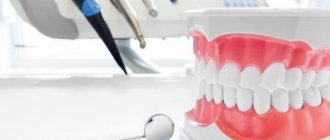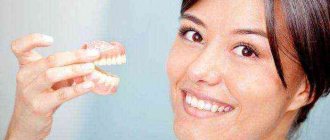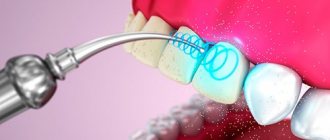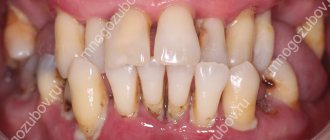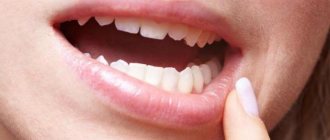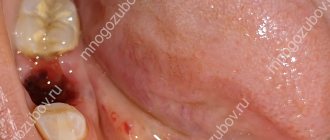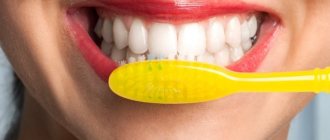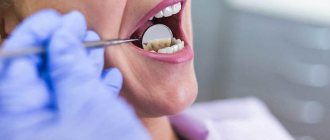Health-improving measures mean the sanitation of the oral cavity: treatment of caries and non-carious lesions of teeth, removal of dental plaque, treatment of diseases of the oral mucosa, removal of teeth and tooth roots that cannot be treated. Oral health measures are mandatory for any patient preparing for prosthetics. Prosthetics for a patient with an unsanitized oral cavity should be considered a serious mistake, because, firstly, it contradicts medical ethics, secondly, accidental injuries to the mucous membrane during orthopedic manipulations can lead to serious complications, thirdly, the prosthetics itself may be defective, since in the future there may be a need for additional tooth extraction and changes in the orthopedic treatment plan in connection with this. And finally, fourthly, the risk of infection of the orthopedic dentist increases. Many diseases of the oral mucosa (leukoplakia, lichen planus, etc.) are chronic, and patients require long-term follow-up and treatment. Treatment often provides temporary success. Delaying prosthetics for these patients is hardly advisable if we approach the issue of prosthetics from the point of view of restoring chewing function and preventing gastrointestinal diseases. In such cases, the question of whether the patient should be given prosthetics is illegitimate. It is only necessary to choose a prosthesis design in which irritation of the oral mucosa would be minimized. We must also not forget that some diseases of the mucous membrane resolve only after appropriate orthopedic treatment. These are ulcerative lesions of the gums with a deep traumatic bite, tongue and cheek with defects in the dentition, etc. Health measures before orthopedic treatment include the mandatory removal of tooth roots, with the exception of those that can be used for prosthetics. In prosthetics, the roots can be used to strengthen artificial stumps with a pin, pin teeth and as a support for removable denture structures. The roots must meet the following requirements: be long enough, stable, stand above the gum and have a healthy periodontium. The root canals must be filled up to the apical foramen. The listed requirements are strict, which makes it practically possible to use roots only for certain groups of teeth. It is difficult to use the roots of the lower incisors because they are short and have narrow canals. The roots of the molars are curved, making them difficult to use as support. The most convenient from this point of view are the roots of the upper anterior central incisors, canines and, less commonly, premolars. All teeth with pathological mobility of III-IV degrees must be removed An exception may be cases when there is atrophy of the socket within the cervical third of the root socket, and pathological mobility was the result of an exacerbation of periodontitis or acute trauma. After the exacerbation or injury is eliminated, the tooth may become somewhat stronger, and the issue of its removal should be discussed again. With atrophy of the alveoli within the middle third of the root, teeth with mobility of I and II degrees are preserved. If the atrophy process has captured the middle third of the socket and reached the border of the apical third, it is possible to preserve the tooth only with degree I mobility in periodontal disease, when the inflammation is weakly expressed. Another condition for preserving a tooth with a similar degree of periodontal damage is its position in the dentition. Single teeth are of little functional value and should be removed. Teeth that are in a row with others can be saved. Teeth with pathological mobility of II and III degrees and the presence of periapical chronic foci of inflammation, even if the root canals are well filled with filling material, must be removed. When deciding on the extraction of a particular tooth with affected periodontal disease, one should take into account its functional value and the role assigned to it in terms of orthopedic treatment. Among the clinical signs that determine the functional value of a tooth, the leading ones are pathological mobility and the ratio of the height of the clinical crown and the length of the root. Pathological tooth mobility depends on the degree of socket atrophy, the width of the periodontal fissure, and the depth of the pathological periodontal pocket. However, there is not always a correspondence between the severity of these signs. For example, with atrophy of the tooth socket at 2/3 of the length of its root, it may have pathological mobility of degree I, and vice versa, with atrophy of the hole in the cervical third of the root, pathological mobility can reach degree II or III. In the case of diffuse periodontal damage, before prosthetics, it is sometimes necessary to remove several teeth, some of which have antagonists that maintain the interalveolar height. After removal, the remaining 2-3 pairs of antagonists experience increased functional load, which especially aggravates the pathological mobility of teeth. The danger of functional overload increases even more if there is a large time gap between the last removal and the start of prosthetics. Under the influence of overload, periodontal dystrophy begins to progress rapidly, as a result of which teeth, previously relatively stable, acquire mobility of the third degree. To prevent this complication, the remaining 2-3 teeth that have antagonists should be splinted before removal. After splinting, teeth extraction begins according to indications. Roots and teeth that do not have antagonists are removed before splinting. Splinting, as a rule, helps prevent functional overload of teeth with healthy periodontium. In case of periodontitis, it is advisable to combine splinting with direct prosthetics. Following the sanitation of the oral cavity, special measures are also carried out according to strict indications, determined by the plan and nature of the upcoming prosthetics. For example, when prosthetizing defects in the dentition with metal-ceramic bridges, there is no need to remove scars that distort the transitional fold. At the same time, when using removable prosthetics, they interfere with the correct construction of the boundaries of the prosthesis base, worsen the habituation to it, and they have to be removed surgically.
Creation and installation of various prostheses: what are the stages and how long will it take?
Article navigation
- Stages of prosthetics
- - reorganization
- — photometry
- - casts
- - choice of prosthesis model
- — design and planning
- — creation of a prosthesis
- - first fitting
- — fixation of the structure
- - education
- How long does it take for production?
- Manufacturing time for fixed dentures
- Production time for removable devices
- Care
- QUESTIONS
Question for a specialist
Modern dental prosthetics are affordable and multivariate solutions for restoring the aesthetics of a smile and the function of chewing. In preparation for restoration, the patient goes through several preparatory stages, which include choosing a doctor and clinic, selecting a prosthetic technique and preliminary treatment - they can take from a couple of days to several months. Detailed materials about this can be found on our website. The creation and installation of structures also consist of various procedures. What stages are involved in direct dental prosthetics, and in what time frames the structures are made, we will describe in detail in this article.
Varieties of clasp structures
Among the clasp systems, the following subgroups are distinguished:
- Lamellar. This technology is considered outdated, but is still in demand, since prostheses produced using this method are low in cost. They are made in a short time from medical plastic in standard sizes and in a certain color range. This design allows you to compensate for partial tooth loss or complete edentia.
- Partially removable devices. Well suited for patients who have retained several teeth. However, the main load goes directly to the prosthesis, so it must fit perfectly to the jaw. Fastening is done using hooks. This option is durable and small in size.
- Nylon or silicone. Such prostheses are also called “invisible”. They are truly transparent, do not have clasps, and are practically indistinguishable from natural teeth. And most importantly, they do not cause allergic reactions, the patient gets used to them in just a couple of days. At the same time, they require regular use of Corega cream. They cannot be adjusted after production.
- One-sided.
These are small structures designed to compensate for a small defect on one side of the jaw. Acrylic dentures have been used in dentistry for more than 20 years. In some cases, they are used as a temporary measure until all lost teeth are implanted. Other patients choose the design as a real opportunity to restore the dentition on a permanent basis. Regardless of the final goal, the price of this type of denture is affordable for almost every person. Acrylic dentures can correct the situation with both complete and partial loss of teeth. When completely edentulous, they are installed on pre-installed implants.
How to install prostheses - stages of prosthetics
After the patient has been diagnosed and is fully prepared, prosthetic procedures begin, which will result in the restoration of lost teeth and a smile transformation. All of them are painless and do not take much time. Below is a description of all stages of dental prosthetics.
Sanitation of the oral cavity
It is a mandatory preparatory stage before prosthetics. Sanitation aims to improve the overall health of the oral cavity and reduce the bacterial load. It includes treatment of living teeth from carious lesions, elimination of inflammatory gum diseases, if necessary, depulpation - removal of the nerve from the tooth, canal filling, as well as a complex of professional hygiene. All this is necessary to create favorable conditions1 before future prosthetics.
ALL TYPES OF REMOVABLE DENTURES!
Dentures made of acrylic from RUR 15,000. Flexible prostheses 22,000 rub. Treatment is guaranteed for up to 2 years! More details about promotions >> Consultation with a doctor is FREE! Choose a denture for yourself: +7
For more information about dental treatment before installing dentures, read the article “Preparation for dentures: stages and procedures for successful dental restoration and long life of dentures.”
Photometry
A series of photographs of the patient's face and jaw are taken from different angles. The photo captures the patient's face with and without a smile, with jaws closed, in a relaxed state and with an open mouth. This is necessary to visually assess changes in occlusion, facial symmetry caused by missing teeth, as well as to record the patient’s “before” appearance. Later, the final result of the prosthetics will also be recorded in the photo and will determine the “after” result.
Taking impressions of the jaws
To create an accurate design, first complete impressions of the upper and lower jaw with the defect area are formed on a special pliable mass. If teeth are restored with complete edentia, then impressions of the gums are made. With their help, the base of the prosthesis and the structure itself are formed, taking into account the bite. For this purpose, devices such as analyzers and face bows are needed. They help to identify the parameters of bite and jaw closure - occlusion, which is of great importance for functionality and organic integration of the structure into the oral cavity.
This way, all the anatomical features of the patient will be taken into account - they are unique for each person. The impressions are sent to a dental laboratory, where a dental technician will evaluate the features of the prosthetic bed, the location of the defect, and take into account the shape and size of adjacent teeth.
Choosing a prosthesis model, teeth shape and color
Based on the diagnostic results, the doctor advises the patient several prosthetic options suitable for his clinical case. The shape and color of the teeth are immediately selected, harmoniously combined with facial features and skin tone. The choice can be made using special palettes, where possible options are presented, or on the monitor screen (if provided) - that is, in digital format. For example, through special software - we will discuss it below.
Digital Design and Planning
Some modern clinics, which have advanced methods of planning and creating dentures, offer their patients to see their future smile in advance and finally decide on their choice. For this purpose, digital smile design technology is used – Digital Smile Design. It allows, based on computed tomography data, to take into account all the anatomical nuances of the patient’s oral cavity even before making the prosthesis and create an artificial structure indistinguishable from natural teeth.
Thanks to the ideal selection of the shape of the teeth and jaw as a whole, taking into account the relationship and proportions of the face, the patient will receive an individually designed prosthesis. The principles of the “golden ratio” and “beauty mask”, embedded in computer modeling, allow you to correct your smile, creating truly harmonious and natural designs.
Creating a prosthesis in a dental laboratory
In the dental laboratory, the impressions obtained are transferred to plaster models - exact copies of the patient's jaws. And on their basis, with the help of special equipment and from various materials, prosthetics are already created. It is possible to manufacture a structure from both acrylic and expensive and durable zirconium dioxide using robotic equipment. It all depends on the type of prosthesis and its purpose.
The construction is manufactured by a dental technician, and an orthopedic surgeon controls the production process, monitors the quality of the parts produced, the accuracy of the transferred parameters and the convenience of future structures.
Today, the equipment of advanced dental laboratories allows us to produce both comfortable removable dentures, as well as crowns, bridges, and complete fixed appliances secured to implants. Most of them are created not manually, but using robotic equipment, including high-precision milling machines, CAD/CAM systems2, high-tech software, 3D printers, high-temperature ovens and more.
Veneers made of E-max ceramics and zirconium dioxide - 20,000 rubles.
All manipulations are included in the price.
Manufacturing and modeling of veneers using CAD/CAM technology. Labor warranty 2 years. Save RUB 10,000. >> Call now or request a call
Opening hours: 24 hours a day - seven days a week
Read about new technologies that can speed up the production of dentures and significantly improve their quality in the article “New technologies and prospects for the development of dental prosthetics.”
First fitting and correction if necessary
To finally ensure the accuracy of the manufactured restoration and its convenience for the patient, the first fitting is carried out. The position of the structure in the mouth is not always comfortable the first time. The doctor can correct the design right on the spot or, if necessary, send it back to the laboratory for a more precise fit.
By the way, correction may be required later, after the final installation. This is often necessary if the patient has had no teeth for a long time, and then the work of the masticatory muscles resumes and the bite changes.
Fixation of the structure in the oral cavity
If the prosthesis fits perfectly and does not cause discomfort, the doctor fixes it in the oral cavity. This moment becomes the most pleasant for the patient, as it brings him closer to the expected result. It takes a little time to install a denture. Depending on the type of device, fixation takes from 20 minutes to 3 hours.
To fix dentures, some kind of support is required: this can be the root of a living tooth, reinforced with an inlay or a metal pin, or pre-installed dental implants (artificial analogues of roots made of metal). In addition, the gums serve as support for removable structures - in case there is a need to restore completely lost teeth in a row.
Teaching the patient the correct use of prostheses
After installation, the doctor must give advice to the patient: what to do with the new artificial teeth, how to carefully remove them from the mouth (if the denture is removable), how to properly care for it and what foods to eat so as not to damage the crowns.
Therapeutic stage
Or “preparing for dental prosthetics.” The main task is to bring oral hygiene into complete order. This means eliminating tartar and removing plaque. Subgingival deposits deserve special attention, because they are most often the causative agent of caries and a source of unpleasant odor.
At this stage, doctors give recommendations for teeth polishing using preparations that contain fluoride (to ensure a long-term attractive appearance and prevent caries). After this, it is worth treating inflammatory processes in the oral cavity (if any), caries and its possible complications. The importance of this process lies in the fact that caries can destroy supporting teeth, the restoration of which is a very labor-intensive, complex and expensive process.
In certain cases, it is recommended to remove the nerves (depulpate) the prosthetic teeth, followed by filling. But, as practice shows, it is better to use a living tooth for prosthetics.
How long does it take to make a prosthesis?
The timing of dental prosthetics with permanent structures varies. The process can take 5–7 days to 3–4 weeks. How long it takes to make dentures depends on the size, shape, material used, and the presence or absence of metal fasteners. Production times are strictly individual. The patient should not be upset if he has to wait longer than he planned for new teeth - while the permanent structures are being manufactured, he will be offered temporary templates, the installation of which will take only a few hours.
DENTAL PROSTHESIS Quattrotti - 40,000 rub. for 1 jaw
All manipulations for the manufacture, installation and fitting of the prosthesis, including impressions, are included.
Save RUR 8,000! >> Call now or request a call
Opening hours: 24 hours a day - seven days a week
Approximate production times for fixed dentures
How long it takes to make a dental crown depends on the method of its fixation. Will it be on a natural tooth, a post and an implant?
| Crown material | Production time, in days |
| Metal-ceramic dental crowns | 5–10 |
| Metal dental crowns | 4–7 |
| Ceramic dental crowns | 4–7 |
| Metal-plastic dental crowns | 5–10 |
| Crowns based on zirconium dioxide | 4–5 |
How long work on dental bridges takes depends on the number and type of crowns that are used as part of the bridge. In general, the technician’s work takes 10 days or more.
Installation of crowns on implants within the framework of one-stage implantation protocols (All-on-4, All-on-6 and others) is possible already on the 3rd day after implantation, since the creation of prostheses begins already at the time of planning the operation itself.
Types of fixed structures
The most common fixed dentures are single crowns. But they can be installed provided the root is preserved, that is, they are used to restore the coronal part.
Other types:
- Bridge-like. They are presented in the form of several crowns that are attached to healthy teeth. The design allows you to evenly distribute the load throughout the jaw.
- Dentures on implants, which can be attached to a ball or beam mount.
- Inlays are one of the types of ceramic dentures. Usually used for damaged chewing teeth in order to preserve their hard tissues.
- Veneers. Most often these are ceramic plates that allow you to restore aesthetics. They are mounted on the front surface and can be used to close large gaps between teeth.
The main advantage of fixed structures is quick adaptation to prostheses and high aesthetic qualities due to almost complete invisibility.
Production time for removable devices
| View | Production time, in days |
| Clasp with hooks | 10–12 |
| Clasp on attachments | from 20 |
| Clasp dental crowns on telescopic crowns | from 20 |
| Nylon | 7–10 |
| Soft plastic | 5–10 |
| Plate and acrylic | 5–7 |
The table shows only the average time for dental technicians to complete work. Depending on the workload, the patient may be asked to complete the work much faster than the stated deadline. However, many dental laboratories operate using the “urgent order” system. Production time can be halved, but at the same time you will pay for urgency.
Timing of dental prosthetics
The timing of prosthetics depends not only on the method of restoration, but also on the selected material. For example, when choosing ceramic structures, we recommend CEREC technology, developed in Switzerland. With her, the issue of prosthetics is resolved in one visit. The doctor processes the tooth, then uses a compact scanning device to create on a computer a 3D model of the cavity and surrounding tissues prepared for prosthetics, forms a template for the future ceramic prosthesis, and also selects the color and desired size. As a result, the desired structure is manufactured using a milling machine within 20 minutes. Thus, the total time spent in the clinic is on average 2-3 hours.
With the classic version of prosthetics, you will need to visit the doctor at least 3 times. The length of appointments will vary depending on the complexity of the denture and the number of teeth.
Standard visit scheme:
- consultation and diagnostic impression taking (from 40 minutes);
- dental treatment (from 1 hour);
- fitting of a prosthesis (from 40 minutes);
- fixation (from 40 minutes).
The time from the first visit to fixation of the prosthesis can take up to 2 weeks - it all depends on the amount of work.
To find out the timing of prosthetics at Stompraktika, we recommend that you visit a consultation with an orthopedic dentist. After the examination, the treatment coordinator together with the doctor will draw up a detailed plan of all necessary procedures, taking into account their duration and cost. For your convenience, we can send a treatment plan by email so you can plan your time in advance.
Maintenance of installed structures
Patients should remember that caring for artificial teeth is no different from caring for natural teeth. It is very important to brush your teeth daily with toothpaste and a brush, and remove food debris after each meal. With removable dentures, this is a mandatory condition, since food debris between the artificial structures and the gums can cause inflammation.
Read more about caring for installed dentures in the material “How to properly care for removable and fixed dentures so that they last as long as possible.”
In addition, you should not eat too hard foods - nuts, seeds, crackers. Artificial teeth can easily break from excessive pressure.
YOUR QUESTIONS AND ANSWERS
QUESTION: Is it possible to make a new tooth if only one root remains from the old one? Or in such a situation, just remove the remains? Gera
ANSWER: If the root is preserved, then the tooth can be restored. There may be several options: use a pin or stump inlay for extension, followed by restoration of the supragingival part. The choice of method depends on the initial situation, so you can definitely say which one is suitable in your case after examining and taking a photo of the tooth.
QUESTION: After prosthetics for both jaws, I developed a problem in my upper jaw. I made a puller, the lower jaw fits well, but the upper jaw puts a lot of pressure on the attachment points. When I take off the prosthesis, the pain does not go away for another two days. I went to the doctor to have him loosen it, and now the prosthesis is falling off. Cornet
ANSWER: Dear Cornet, we are very sorry for your situation! First of all, it is important to understand that when installing removable structures, if you have not worn them before, there is an adaptation period. And in many cases it can be quite long and takes 2-3 months. During this time, you need to take out your removable denture only for cleaning after meals, but try to wear it the rest of the time so that the oral cavity adapts. In your situation, the compression of the gums at the attachment site could have been eased slightly, and over time the tissue would have gotten used to it. After the correction, the prosthesis began to fall out, perhaps due to the fact that the specialist was overzealous and removed a little more than necessary. Unfortunately, it is impossible to return the former boundaries of a removable denture - only to make a new one. Alternatively, you can try a special adhesive denture adhesive to improve bonding. It can be bought at a pharmacy.
1Belousov N.N. Time and sequence of stages of complex treatment of inflammatory periodontal diseases // Periodontology. – 2007. 2Razumnaya Z.V. Improving the technology of manufacturing dentures using CAD/CAM systems, 2012.
Author: Chorny S.V. (Thank you for your help in writing the article and the information provided)
Indications for dental prosthetics with removable dentures
Partial and complete removable dentures are a variant of orthopedic structures that replace partial or complete edentia.
Removable structures are made in the following clinical situations:
- End defects of the dentition;
- Included defects are of large extent;
- Loss of chewing teeth on one side of the jaw;
- Complete edentia;
- Pathologies of periodontal tissues (periodontitis, periodontal disease). Often, for patients suffering from severe forms of periodontitis, removable dentures are the only acceptable method of orthopedic treatment .
When choosing any type of orthopedic design, you should seek advice from a dental clinic. After examining the oral cavity, highly qualified doctors will give recommendations based not only on the indications and contraindications for a particular type of prosthetics, but also on the specific clinical situation.
Date of publication: September 20, 2020 Last update: September 22, 2020 © 2020 Professorial Dentistry “22 Century”. All rights reserved.

